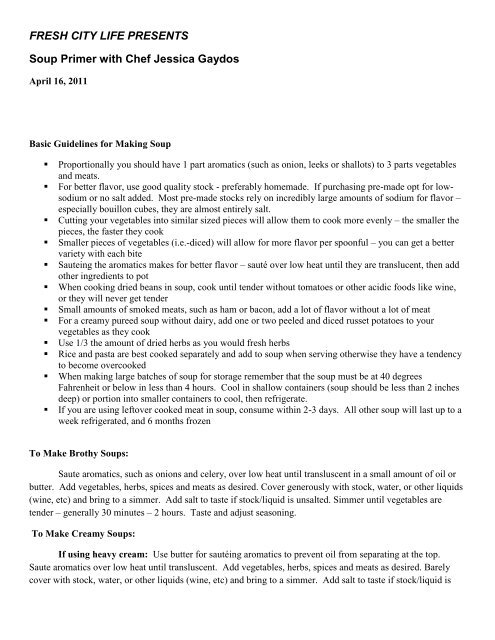Stone Soup Primer - Denver Public Library
Stone Soup Primer - Denver Public Library
Stone Soup Primer - Denver Public Library
You also want an ePaper? Increase the reach of your titles
YUMPU automatically turns print PDFs into web optimized ePapers that Google loves.
FRESH CITY LIFE PRESENTS<br />
<strong>Soup</strong> <strong>Primer</strong> with Chef Jessica Gaydos<br />
April 16, 2011<br />
Basic Guidelines for Making <strong>Soup</strong><br />
• Proportionally you should have 1 part aromatics (such as onion, leeks or shallots) to 3 parts vegetables<br />
and meats.<br />
• For better flavor, use good quality stock - preferably homemade. If purchasing pre-made opt for lowsodium<br />
or no salt added. Most pre-made stocks rely on incredibly large amounts of sodium for flavor –<br />
especially bouillon cubes, they are almost entirely salt.<br />
• Cutting your vegetables into similar sized pieces will allow them to cook more evenly – the smaller the<br />
pieces, the faster they cook<br />
• Smaller pieces of vegetables (i.e.-diced) will allow for more flavor per spoonful – you can get a better<br />
variety with each bite<br />
• Sauteing the aromatics makes for better flavor – sauté over low heat until they are translucent, then add<br />
other ingredients to pot<br />
• When cooking dried beans in soup, cook until tender without tomatoes or other acidic foods like wine,<br />
or they will never get tender<br />
• Small amounts of smoked meats, such as ham or bacon, add a lot of flavor without a lot of meat<br />
• For a creamy pureed soup without dairy, add one or two peeled and diced russet potatoes to your<br />
vegetables as they cook<br />
• Use 1/3 the amount of dried herbs as you would fresh herbs<br />
• Rice and pasta are best cooked separately and add to soup when serving otherwise they have a tendency<br />
to become overcooked<br />
• When making large batches of soup for storage remember that the soup must be at 40 degrees<br />
Fahrenheit or below in less than 4 hours. Cool in shallow containers (soup should be less than 2 inches<br />
deep) or portion into smaller containers to cool, then refrigerate.<br />
• If you are using leftover cooked meat in soup, consume within 2-3 days. All other soup will last up to a<br />
week refrigerated, and 6 months frozen<br />
To Make Brothy <strong>Soup</strong>s:<br />
Saute aromatics, such as onions and celery, over low heat until transluscent in a small amount of oil or<br />
butter. Add vegetables, herbs, spices and meats as desired. Cover generously with stock, water, or other liquids<br />
(wine, etc) and bring to a simmer. Add salt to taste if stock/liquid is unsalted. Simmer until vegetables are<br />
tender – generally 30 minutes – 2 hours. Taste and adjust seasoning.<br />
To Make Creamy <strong>Soup</strong>s:<br />
If using heavy cream: Use butter for sautéing aromatics to prevent oil from separating at the top.<br />
Saute aromatics over low heat until transluscent. Add vegetables, herbs, spices and meats as desired. Barely<br />
cover with stock, water, or other liquids (wine, etc) and bring to a simmer. Add salt to taste if stock/liquid is
unsalted. Simmer until vegetables are tender – generally 30 minutes – 2 hours. Taste and adjust seasoning.<br />
Add a small amount of cream and reheat gently.<br />
If using milk: Saute aromatics, such as onions and celery, over low heat until transluscent in a 2-4<br />
Tablespoons of oil or butter. Sprinkle an equal amount of all-purpose flour as oil/butter over aromatics, stir to<br />
coat well and cook over medium heat for about 2 minutes, stirring constantly (you want to cook off the raw<br />
flour taste). This will create a roux to thicken the liquid. Add vegetables, herbs, spices and meats as desired.<br />
Barely cover with stock, water, or other liquids (wine, etc), stirring constantly to dissolve the flour, and bring to<br />
a simmer. Add salt to taste if stock/liquid is unsalted. Simmer until vegetables are tender – generally 30<br />
minutes – 2 hours. Taste and adjust seasoning. Add a small amount of milk to taste and reheat gently (do not<br />
boil or it will curdle).<br />
Making Stock:<br />
The goal of making your own stock is to create a flavorful liquid for cooking – an easy way to add flavor with<br />
few calories! No need to worry over it – think of it more as a thrifty way to use what you have on hand than a<br />
specific formula!<br />
Guidelines For Vegetable Stock<br />
• Most vegetables do well in stock – just keep in mind that strong flavored ones may overpower the rest!<br />
Cabbage and other cabbage family (broccoli, etc) do not take well to long cooking and make the stock<br />
taste a little off. The only exception is turnip, a very little is ok. Potatoes will make the stock cloudy<br />
and bland. Beets will make the stock red and too earthy. Tomatoes should be used sparingly.<br />
• Veggie scraps, herb stems and clean carrot and parsnip peels work just as well as whole vegetables, just<br />
make sure no spoiled or rotting bits get into the pot and dirt is cleaned off<br />
• A little onion skin will help the stock have nice color, but too much will make it bitter. 1-2 onion skins<br />
are usually enough.<br />
• Strong herbs, such as rosemary, fennel or dill will limit the use of your stock. Fresh parsley and thyme<br />
are best.<br />
• A few whole peppercorns add flavor without overwhelming the stock, do not salt or finished dishes may<br />
end up too salty<br />
• Mushrooms or mushroom stems can be used, but only use a few if you don’t want it too mushroomy<br />
tasting<br />
• Scraps and veggie pieces can be kept in the freezer in bags until enough accumulate for a stockpot-full<br />
of stock<br />
• Always use raw vegetables and herbs<br />
To make stock: Place 1-3 pounds of mixed vegetables and/or vegetable trimmings in a large stockpot. Add<br />
a few peppercorns and sprigs of herbs. Cover with COLD water, place a lid on the pan and bring to a<br />
simmer. Simmer 1/2 – 11/2 hours, then strain. If the stock needs to be stronger, place strained stock back in<br />
stockpot and boil until reduced to desired strength. Cool stock, portion into containers (2 cup portions work<br />
well), and freeze, if desired. Stock keeps one week refrigerated, 6 months frozen.<br />
Guidelines for Chicken Stock<br />
• Raw chicken pieces, raw bones or leftover bones from a roasted chicken may all be used for stock. To<br />
make an amount worth the effort, 2-3 carcasses should be used. Carcasses can be kept in the freezer<br />
until you have enough to make a batch.<br />
• Giblets, gizzards, wingtips and hearts may be used, but DO NOT use the liver.<br />
• Chop bones for best flavor – the smaller the pieces the more flavor they release
• You can use whole cleaned chicken bones to make stock and use the meat for another purpose (<br />
sandwiches, salads, etc)<br />
• Most vegetables do well in stock – just keep in mind that strong flavored ones may overpower the rest!<br />
Cabbage and other cabbage family (broccoli, etc) do not take well to long cooking and make the stock<br />
taste a little off. The only exception is turnip, a very little is ok. Potatoes will make the stock cloudy<br />
and bland. Beets will make the stock red and too earthy. Tomatoes should be used sparingly.<br />
• Veggie scraps, herb stems and clean carrot and parsnip peels work just as well as whole vegetables, just<br />
make sure no spoiled or rotting bits get into the pot and dirt is cleaned off<br />
• A little onion skin will help the stock have nice color, but too much will make it bitter. 1-2 onion skins<br />
are usually enough.<br />
• Strong herbs, such as rosemary, fennel or dill will limit the use of your stock. Fresh parsley and thyme<br />
are best.<br />
• A few whole peppercorns add flavor without overwhelming the stock, do not salt or finished dishes may<br />
end up too salty<br />
• Mushrooms or mushroom stems can be used, but only use a few if you don’t want it too mushroomy<br />
tasting<br />
• Scraps and veggie pieces can be kept in the freezer in bags until enough accumulate for a stockpot-full<br />
of stock<br />
• Always use raw vegetables and herbs<br />
To Make Stock: Place 2-6 chicken carcasses in a large stockpot with 1-2 pounds mixed vegetables<br />
(usually carrots, leek tops, sliced onion, celery), a couple peppercorns and a few sprigs of herbs. Cover<br />
with COLD water and a lid (the lid is to help keep your house from smelling like stock. If you have a<br />
good hood exhaust a lid is not necessary); bring to a boil over medium heat. Reduce heat and simmer 3-<br />
5 hours, skimming any foam off the top. Strain stock and either portion into 2-3 cup portions or place in<br />
a shallow pan to cool. (For food safety reasons, this stock must cool to 40F within 2 hours – small<br />
portions or a large shallow pan help with this – an ice bath for the pan can also help. Putting a large<br />
amount of stock to cool in the refrigerator will raise the temperature of the fridge too much, so the<br />
above methods are best ) If stock is not strong enough , replace stock in stockpot after straining and boil<br />
until desired strength is reached. Stock keeps 1week refrigerated, or 6 months frozen. (Jessica Gaydos)<br />
Quick Asparagus <strong>Soup</strong><br />
<br />
<br />
<br />
<br />
<br />
<br />
<br />
1-3 teaspoons butter or extra virgin olive oil<br />
1/2 medium onion, diced<br />
2-3 cups chopped asparagus, frozen or fresh<br />
1 small potato, peeled and diced very small, optional (use it to replace the cream or if you want to use<br />
milk)<br />
2-3 cups vegetable or chicken stock, low sodium or homemade<br />
salt & pepper, to taste<br />
1/4 cup heavy cream or milk, optional<br />
In a large saucepan, heat butter or oil and add the onions. Cover and let sweat and soften for 5-6 minutes. Add<br />
the asparagus (and potato, if using) and pour on enough stock to barely cover. Season with pepper, and if stock<br />
is unsalted, with salt. Bring to a boil, then lower heat and simmer, UNCOVERED, until veggies are tender,<br />
about 10 minutes. (If you cover the pan while the asparagus - or most green veggies - are cooking, they will<br />
turn an unappetizing greyish color) Remove from heat and taste for seasoning. Carefully puree in batches and<br />
recombine soup in a saucepan and add the cream. (If you want to serve the soup chilled, forget the saucepan<br />
and recombine the soup and mix in the cream in a large shallow bowl. Cool in the refrigerator.) Reheat gently
and do not bring to a boil or the soup may curdle. This will make 2-4 servings and will last for up to a week<br />
refrigerated. (Jessica Gaydos)<br />
Corn Chowder<br />
<br />
<br />
<br />
<br />
<br />
<br />
<br />
<br />
<br />
<br />
<br />
<br />
1 small onion, diced<br />
1-2 stalks celery, diced<br />
2-3 Tablespoons butter (use larger amount for thicker soup)<br />
2-3 Tablespoons all-purpose flour (use larger amount for thicker soup)<br />
3 cups good quality chicken or vegetable stock<br />
8 ounces (1/2 lb) potatoes, peeled if desired, and finely diced (starchy potatoes like Russets will make<br />
for a creamier soup, waxy ones like Yukon Golds will be firmer and the soup will be thinner)<br />
3 cups corn kernels, either fresh or frozen<br />
1 Tablespoon chopped fresh parsley<br />
1 Bay Leaf<br />
1 teaspoon minced fresh thyme (or 1/4 teaspoon dried thyme)<br />
Salt & Pepper, to taste (If using prepared stock, you will most likely not need to add any salt)<br />
Milk, to taste - approximately 1/4-1/2 cup<br />
Melt butter in a large pot. Add diced onions and celery and cook over medium heat 6-8 minutes, or until soft<br />
but not browned. Add flour, stir to combine completely and cook over medium heat for 1-2 minutes or until<br />
bubbly (to cook away the raw flour taste and make a roux for thickening the soup). After the roux (flour and<br />
butter mixture) has cooked, gradually whisk in the stock and stir until smooth (there will still be the chinks of<br />
onion and celery, but the liquid should be smooth). Add potatoes, corn, thyme, parsley and bay leaf. Season to<br />
taste. Bring to a simmer and cook until potatoes are tender 15-30 minutes, depending on the size and type of<br />
potato. Mixture should seem a little thicker than you'd like it, as adding the milk will thin it out. If the soup is<br />
too thin, raise the heat and boil uncovered until it reduces to the thickness you desire. Add milk until the<br />
preferred consistency is reached and check the seasoning. Gently heat soup up on medium heat until it reaches<br />
desired temperature. Serves 4 as a main course. Will last 4-5 days, refrigerated. If desired, garnish with<br />
shredded cheddar cheese and chopped green onions or parsley. (Jessica Gaydos)<br />
Carrot and Cumin <strong>Soup</strong><br />
• 2 teaspoons whole cumin seeds<br />
• 1 Tablespoon butter<br />
• 1 cup onion, chopped<br />
• 1 cup potatoes, peeled and chopped<br />
• 3 cups carrots, peeled and chopped<br />
• Salt, pepper and sugar, to taste<br />
• 5 cups chicken or vegetable stock<br />
• ½ cup whole milk or half and half, optional<br />
Heat the cumin seeds in a small frying pan over medium heat for a minute or two to toast them – they will start<br />
to smell rich and spicy. Grind in a mortar and pestle or in a spice grinder. Melt the butter in a large saucepan.<br />
When butter starts to foam, add vegetables and cumin. Season with salt (unless stock already has salt added),<br />
pepper and a pinch of sugar. Cover and cook over low heat 10 minutes, or until vegetables have softened
slightly. Remove the lid and add the stock. Bring to a boil, then simmer until vegetables are soft. Puree until<br />
smooth, in batches if necessary. Taste and adjust seasoning. Add milk if desired and reheat gently – do not boil<br />
or mixture will curdle. Serves 6. Will last 1 week, refrigerated. (Adapted from Darina Allen and the<br />
Ballymaloe Cookery School)<br />
<strong>Soup</strong>e au Pistou<br />
• 1 cup (6 oz) Dried Flageolet or other white bean, soaked overnight in cold water, then rinsed and drained<br />
• 10 cups chicken stock or water, or a combination<br />
• 4 Tablespoons Extra Virgin Olive Oil<br />
• Salt and pepper, to taste<br />
• 2 medium leeks, cut into ¼” slices<br />
• 2 small white turnips, cut into ¼” dice<br />
• 3 large carrots, cut into ¼” dice<br />
• 2-3 small zucchini, cut into ¼” dice<br />
• 1 stalk celery, cut into ¼” dice<br />
• 2 potatoes, peeled and cut into ¼” dice<br />
• 4 ripe tomatoes, peeled and chopped (can use canned)<br />
• 10 oz green beans cut into ½” lengths<br />
• Pistou (Puree 5 cloves garlic, approximately 30 basil leaves and 8 Tablespoons good quality Extra<br />
Virgin Olive Oil. Stir in ½ cup freshly grated parmesan) OR use good quality jarred pesto<br />
In a large stockpot, cover the soaked dried beans with the stock or water. Bring to a boil then lower heat to<br />
medium low and simmer until beans are tender – 45 – 90 minutes. When beans are almost cooked, heat the<br />
olive oil in a large sauté pan. Add the remaining ingredients except green beans, seasoning to taste, and sauté<br />
for 3-4 minutes. Add entire vegetable mixture to the beans and cooking liquid. Stir well. Cover and simmer for<br />
an additional 30 minutes, covered. Uncover and simmer for another 15 minutes. Add green beans and simmer,<br />
uncovered, an additional 8 minutes, or until tender. Meanwhile make the Pistou. Stir Pistou into soup right<br />
before serving. Taste soup and adjust seasoning. DO NOT boil again or it will curdle. Serve with additional<br />
parmesan and olive oil for drizzling, if desired. Serves 10. Without Pistou added, soup will last 5one week<br />
refrigerated. (Adapted from Darina Allen and the Ballymaloe Cookery School)<br />
Broccoli Cheese <strong>Soup</strong><br />
• 1 small onion, diced<br />
• 1 head of broccoli, chopped (you can cut as large or small as you wish). Peel and chop stems as well.<br />
• 2-4 Tablespoons butter or oil<br />
• 2-4 Tablespoons all-purpose flour<br />
• Salt and pepper to taste<br />
• 1 bay leaf, optional<br />
• Enough chicken or vegetable stock to barely cover vegetables – 2-3 cups<br />
• Milk, to taste (about ¼ - ½ cup)<br />
• Approximately 2 cups grated cheese, cheddar or a mixture<br />
Saute onion in butter or oil over low heat in a large saucepan or stockpot until translucent and soft. Add broccoli, sauté<br />
for a minute. Season to taste with salt and pepper. If stock is full flavored you may not need any salt – also remember<br />
cheese will add salt to the finished soup. Sprinkle an equal amount of flour as butter/oil over vegetables and sauté 2<br />
minutes, stirring constantly, to cook off any raw flour taste. If you want a thicker soup, use the larger amounts.
Gradually add the stock, stirring until flour is dissolved. Add bay leaf, if desired. Bring to a simmer and cook until<br />
broccoli is soft and tender. Lower heat to low and stir in milk. Gradually mix in cheese, stirring constantly to melt.<br />
Reheat gently, but do not boil as soup will curdle. <strong>Soup</strong> is best eaten when it is made as reheating can easily separate the<br />
cheese and make it grainy. Serves 4-6. (Jessica Gaydos)<br />
For more great classes, workshops and information about cultural<br />
programming, please support Fresh City Life through Facebook and/or<br />
Twitter.













